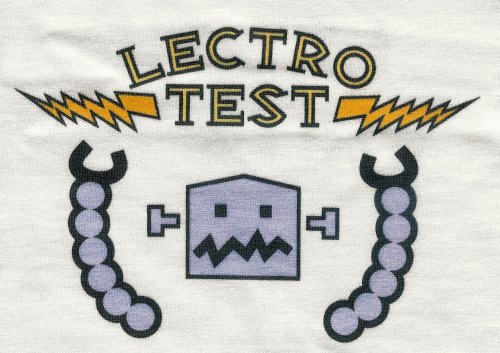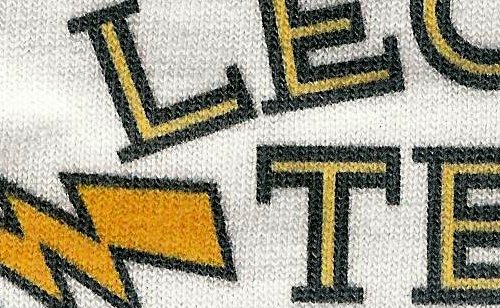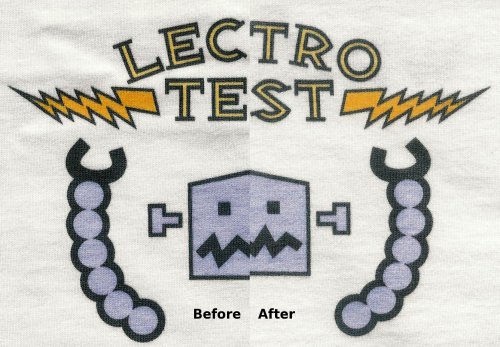As you may recall from a previous post, I set up a CafePress store to sell LectroTest Robot–branded stuff such as t-shirts, hats, mouse pads, magnets, and so on. CafePress does a good job of making their products appear to be of the highest quality, but I am naturally skeptical about such claims.
In particular, I wondered about their t-shirts. The results of their heat-transfer printing process – previously the only option – did not make me happy. Images with transparent areas revealed the transfer background, which over time yellowed and made the image seem to float on a sea of urine.
So when I set up The LectroTest Emporium, I specified the use of CafePress’s newer “direct-printing” process for t-shirts, hats, and every other product for which it was offered. Still, I wondered about the quality.
So I ordered up a LectroTest Robot t-shirt and put it to the test.
Test one: the eyeball and the scanner
When the t-shirt arrived, my initial impression was that it looked pretty darn good. The Robot came out perfectly, and even the pointy parts of the LectroTest lightning rendered without problems. The colors were true, if a little less saturated than I would have preferred.
Compared to silkscreen, the direct-printing process seems to produce results that are a bit less saturated and a bit less crisp. It’s like an airbrush artist rendered the Robot onto a billboard-sized shirt that was carefully shrunken to normal size.
Next, I threw the t-shirt on a flatbed scanner. The results are below. The first image is an overall view of the Robot logo. The second is a 300-dpi close-up of the lettering, where you can see the air-brush effect.


Test two: the iron
To check for color offsetting, I turned the shirt inside out and ironed it on a full-steam, cotton setting. Throughout the ironing, the face of the front-side image was pressed into the white cotton of the back side of the shirt. Nevertheless, none of the ink migrated. The pure white remained pure white.
Test three: the washer
For the final test, I washed the shirt on a normal warm/cold cycle with a small load of other clothes. I then dried the clothing on a medium cycle. (CafePress recommends washing in cold water and drying on low, but nobody pampers their t-shirts like that, and so I tested under more typical conditions.)
When I took the shirt from the dryer, I didn’t see any signs of shrinkage or fading. To double-check, I ironed the shirt and threw it back on the flatbed scanner.
Doing a before-and-after comparison of the scans in the Gimp, I was able to see some shrinkage and fading (see image below). Top to bottom, the shirt shrank by about 4.5 percent; left to right, the shirt actually grew by about 1.8 percent. Minor fading was apparent, especially in the solid black areas. Neither the shrinkage nor the fading were concerning, however; both are typical for t-shirts, especially on the initial washing. The bottom line is that the shirt’s coolness was untarnished.

Summary
It’s a good t-shirt. It looked cool out of the box and fully captured the metallic fierceness of the beloved LectroTest Robot. The shirt handled a hot-steam ironing without any ink offsetting. It shrank and faded a bit on its initial wash, but neither change detracted meaningfully from the shirt. In sum, CafePress’s direct-printed t-shirts seem like the real deal: they look good and stand up to typical wear and washing.